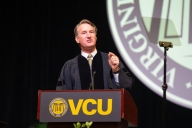You have /5 articles left.
Sign up for a free account or log in.
This week, Stanford University and Washington University in St. Louis joined a growing number of elite private institutions that have substantially increased grants for students deemed financially needy. Stanford's initiative will, in essence, eliminate tuition for students whose families earn less than $100,000. And Washington University is replacing loans with grants for students whose family income is under $60,000.
A panel of college leaders and outside experts led off its higher education discussion, "Does It Really Have to Cost So Much?," by putting the Stanford announcement, in particular, into context. While no one had anything negative to say about the effort to make college more affordable for students there, several panelists echoed a point that was made after Harvard University unveiled its aid initiative: What about everyone else?
The vast majority of students never would consider applying to Stanford or Harvard (largely because they wouldn't make the cut), and most colleges would argue that they'd love to offer such packages but can't because of their less gargantuan endowments. Patrick Callan, founding president of the National Center for Public Policy and Higher Education, said it's a case of "very wealthy colleges" acting in a way that's beneficial to their own students, but that "presents a distorted view that this is the future of what Americans going to college will face."
"Only a handful of colleges can do this," Callan said. "It doesn't reflect the reality for most students going to college next fall."
Jared Bernstein, director of the Living Standards Program at the Economic Policy Institute, agreed that only a finite number of institutions can make such a pledge, but said it does increase accessibility if students who otherwise wouldn't think about attending Stanford end up applying.
The forum, co-sponsored by the nonprofit group Public Agenda and the National Center for Public Policy and Higher Education, and held at George Washington University, included a broader discussion of the economics of higher education and how cost factors into enrollment decisions.
Callan said it's becoming increasingly possible to predict with success whether a student is likely to attend college or not based on the family income. Likewise, he said it's easier and easier to predict whether a student will go to a two-year public, state flagship or private college.
"It's very stratified by income," Callan said. "It turns out the choice is determined most often not by talent but by money, which isn't the system that Americans envisioned."
John Immerwahr, senior research fellow at Public Agenda, who helped write a study that looks at access issues, said that while all signals to students say attend college, more and more people perceive a higher education as being out of their reach. William E. Kirwan, chancellor of the University System of Maryland, said he agrees that the system is leaving students behind.
"We're on the verge of a huge crisis in our country because access to college is essentially the only chance to have a high quality of living and good income," he said. "Twenty, 30, 40 years ago lots of jobs didn't require a degree, but now if you're in the lowest (income) quintile and you don't go to college, odds are you'll stay in poverty."
Still, Bernstein and a student panelist argued that while some colleges might be out of reach for financially needy students, plenty of grant money is attainable for almost anyone who earns it academically and takes time to search.
Steven Knapp, president of George Washington University, said colleges can do a better job publicizing their aid offerings. Responding to a question about what it's like to hear the "most expensive college" label put on his institution, Knapp said "that's a problem" if the public focuses on sticker price and doesn't consider the aid packages. He pointed to the institution's affordability initiative that includes moderating the growth of tuition for all students.
Knapp also noted that, even with the current sticker price, George Washington isn't having trouble attracting students.
"The reality is when we look at our application numbers, we haven't seen evidence that our costs are deterring students from coming to our university," Knapp said. "This may be a factor over time, and there may be segments that will struggle [in paying the cost of attending.]"
Knapp said he's concerned about debt burden of students across the country and how it affects their post-graduation career choices. Callan added that a growing problem is first-generation students who aren't socialized into what he calls "the debt culture" and won't consider college if it means taking out any loans.
Moving toward more need-based aid and tuition-fixing policies (for entering students over their time at a given institution) were two cost solutions mentioned by Knapp.
James Boyle, president of College Parents of America, a four-year old advocacy group, said the perception from parents is that colleges aren't doing everything they can do to hold down costs. The Public Agenda report also showed that 44 percent of those surveyed consider "waste and mismanagement" a "major factor" in driving up the price of college.
Immerwahr said dozens of presidents he interviewed for his report reported feeling helpless in their ability to significantly cut costs by taking a piecemeal approach. They said they need more state and federal support, as well as help from private sources.








